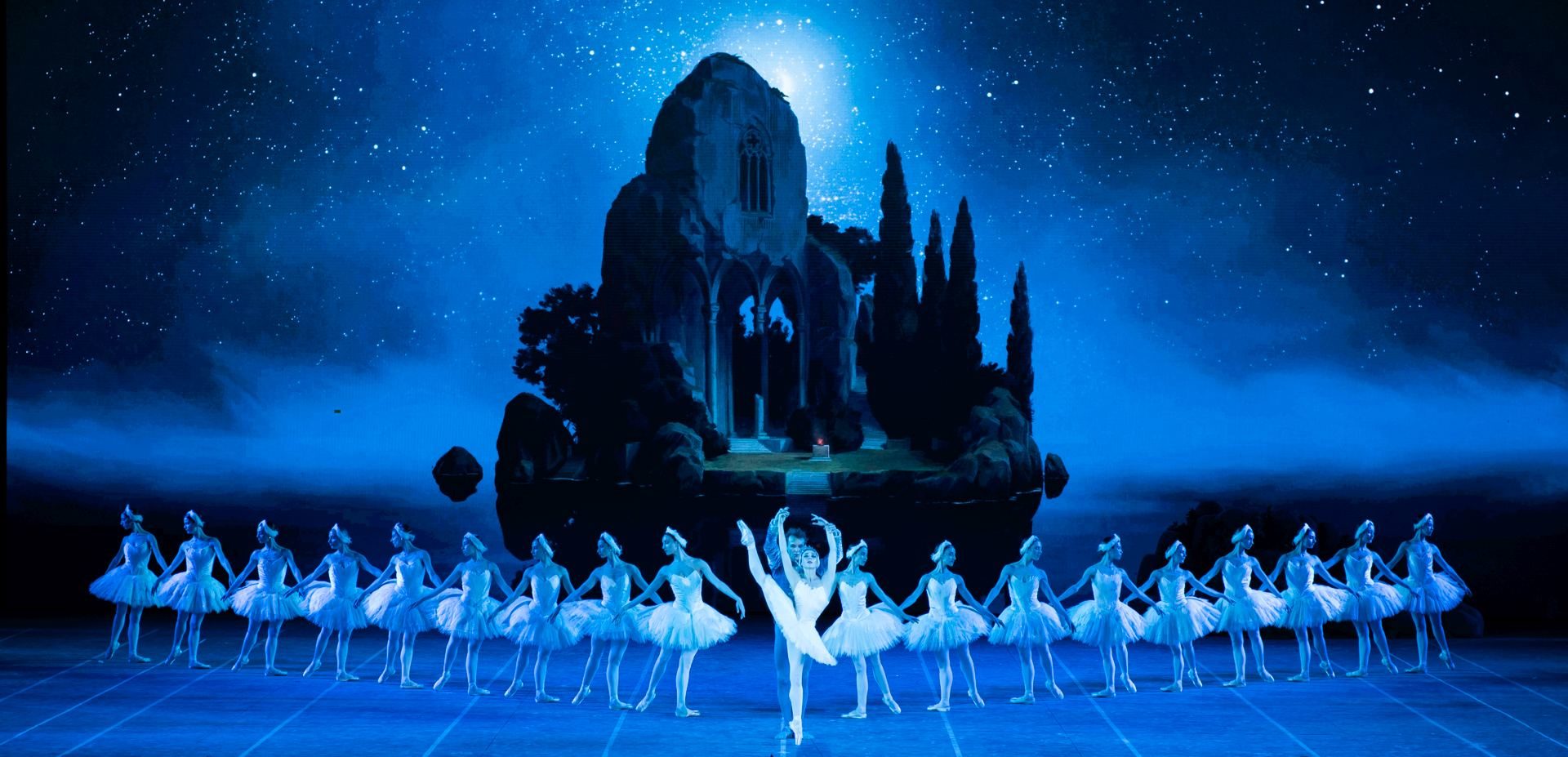“Carmen”
Ballet of the Teatro dell’Opera di Roma
Teatro dell’Opera di Roma
Rome, Italy
February 09, 2019
by Ilona Landgraf
Copyright © 2019 by Ilona Landgraf
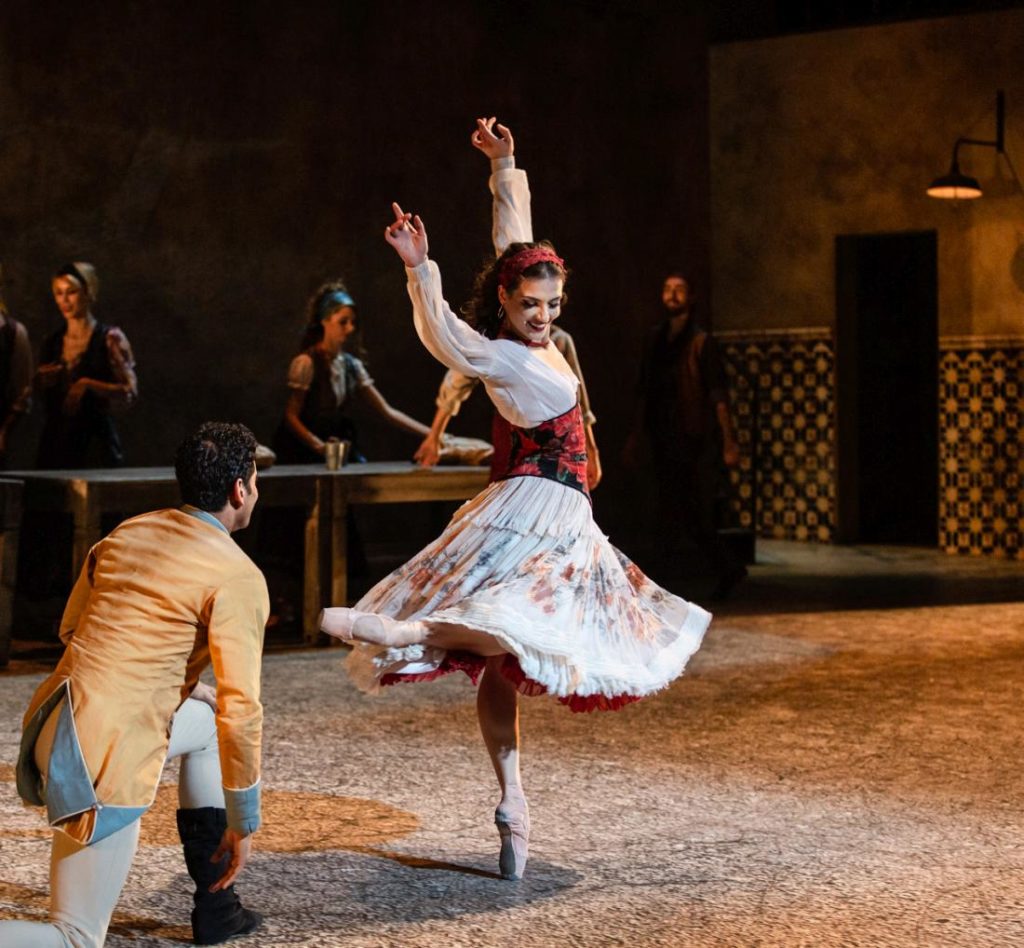 It is said that Czechs are good storytellers. Such generalizations are prone to rebuttal but that’s not the case for Jiří Bubeníček. He has delivered an array of fine pieces over the last years: “Faun”, “The Piano”, “Doctor Zhivago”, “Anita Berber – Goddess of the Night” – to name just a few. His new narrative ballet, “Carmen”, which premiered at the Teatro dell’Opera di Roma in early February, is convincing too. It’s intense, coherent, and fresh.
It is said that Czechs are good storytellers. Such generalizations are prone to rebuttal but that’s not the case for Jiří Bubeníček. He has delivered an array of fine pieces over the last years: “Faun”, “The Piano”, “Doctor Zhivago”, “Anita Berber – Goddess of the Night” – to name just a few. His new narrative ballet, “Carmen”, which premiered at the Teatro dell’Opera di Roma in early February, is convincing too. It’s intense, coherent, and fresh.
When we talk about “Carmen”, it’s easy to think immediately of Bizet’s opera, which failed at its premiere in 1875 and still won international acclaim after the composer’s premature death. Dance aficionados might also know Roland Petit’s 1949 ”Carmen”-ballet and Alberto Alonos’s 1967 “Carmen- Suite”, which both condense the source plot to around forty minutes. The pieces’ literature source – a novella penned in 1847 by Prosper Mérimée (1803 – 1870) is less popular. This is where Bubeníček dug deep. As in the original telling, Bubeníček replaced the opera’s antagonist Micaëla with Mérimée (Damiano Mongelli), a novelist who observes alongside us and writes what he sees in a novella. Unlike Petit and Alonso, Bubeníček included many details; one might argue that there are too many. Regardless, even if you miss a detail or two, you never lose the thread. Bubeníček was assisted this time by a long-term friend, Arsen Mehrabyan, who is a principal dancer of the Royal Swedish Ballet and a choreographer himself.
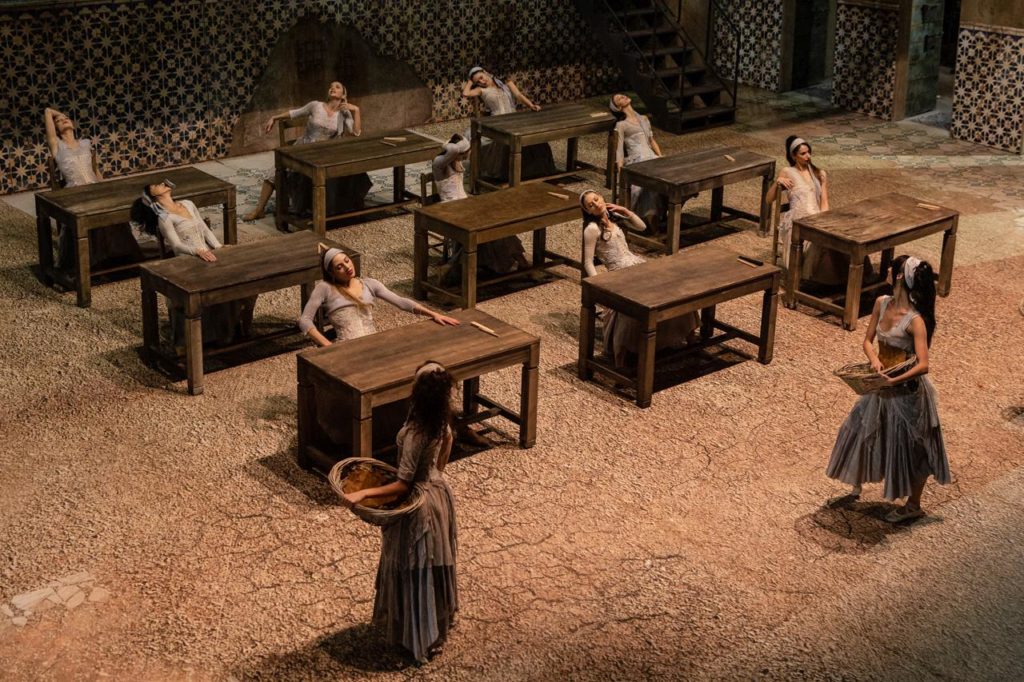 Most of the music is Bizet’s, complemented by compositions from Manuel de Falla, Isaac Albéniz, and others. The score was played by the orchestra of the Teatro dell’Opera di Roma under the baton of Louis Lohraseb. His program notes highlight how important the Teatro dell’Opera di Roma was to Bizet’s career. Prologue and epilogue are played by an onstage accordionist (Angelo Miele), who infuses the famous tunes with a pensive hesitance. At a party, a guitarist (Arturo Tallini) plays flamenco for the dancing guests. He is later joined by a flutist (Raffaele Bifulco) for a melancholy duet that accompanies the ongoing conflicts raging both among the smugglers and between the smugglers and the soldiers.
Most of the music is Bizet’s, complemented by compositions from Manuel de Falla, Isaac Albéniz, and others. The score was played by the orchestra of the Teatro dell’Opera di Roma under the baton of Louis Lohraseb. His program notes highlight how important the Teatro dell’Opera di Roma was to Bizet’s career. Prologue and epilogue are played by an onstage accordionist (Angelo Miele), who infuses the famous tunes with a pensive hesitance. At a party, a guitarist (Arturo Tallini) plays flamenco for the dancing guests. He is later joined by a flutist (Raffaele Bifulco) for a melancholy duet that accompanies the ongoing conflicts raging both among the smugglers and between the smugglers and the soldiers.
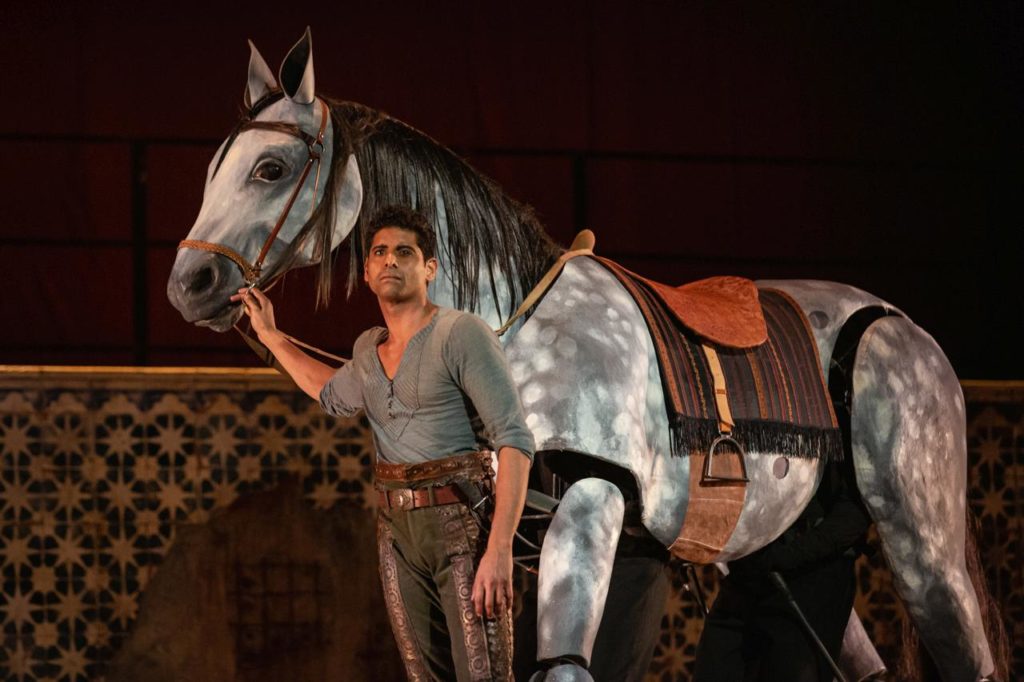 Gianni Carluccio’s set transforms effortlessly into a number of locations. It’s a rectangular, slightly-decayed space with eight side-exits whose walls are covered with blue-patterned tiles up to the ceiling. Two metallic ladders at the back wall lead to an elevated, multi-functional promenade, on which the cigar factory’s female workforce struts lasciviously and Carmen (Susanna Salvi) robs wealthy passersby. Rows of work benches and a large photo of an old stone building mark the interior of the cigar factory; two chandeliers, a red lounge, and two golden, high-hanging corner elements depict the home of the English general (Guiseppe Depalo) with whom Carmen has an affair. Sevilla’s streets and various forests and mountains are shown with photos and video projection; old church paintings represent the basilica where Don José (Amar Ramasar) begs Carmen to abandon her past and start anew with him. Every time a metallic fence is lowered onto the tilted walls, we see Don José in prison.
Gianni Carluccio’s set transforms effortlessly into a number of locations. It’s a rectangular, slightly-decayed space with eight side-exits whose walls are covered with blue-patterned tiles up to the ceiling. Two metallic ladders at the back wall lead to an elevated, multi-functional promenade, on which the cigar factory’s female workforce struts lasciviously and Carmen (Susanna Salvi) robs wealthy passersby. Rows of work benches and a large photo of an old stone building mark the interior of the cigar factory; two chandeliers, a red lounge, and two golden, high-hanging corner elements depict the home of the English general (Guiseppe Depalo) with whom Carmen has an affair. Sevilla’s streets and various forests and mountains are shown with photos and video projection; old church paintings represent the basilica where Don José (Amar Ramasar) begs Carmen to abandon her past and start anew with him. Every time a metallic fence is lowered onto the tilted walls, we see Don José in prison.
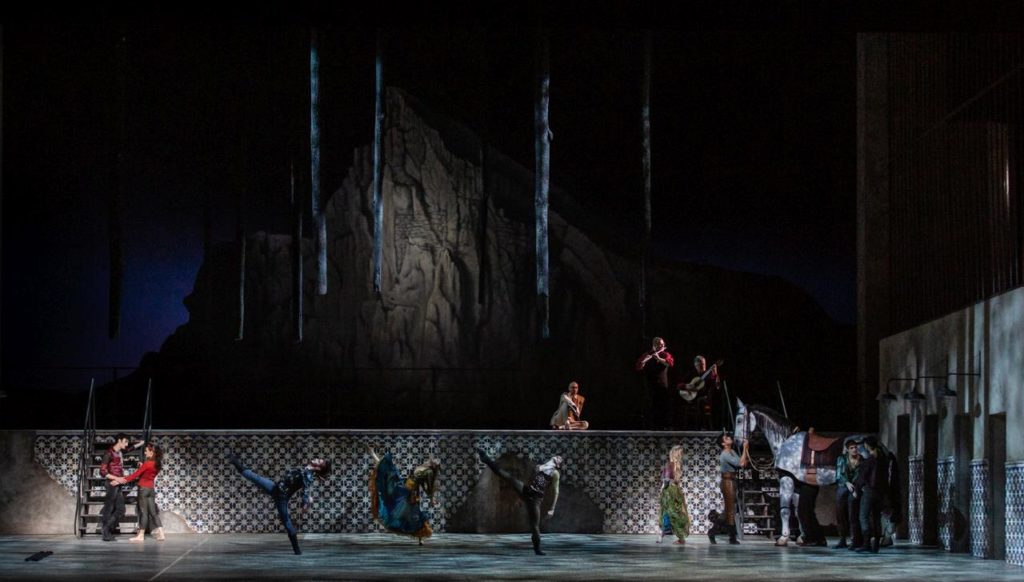 The lighting, also by Carluccio, evokes the black silhouette of a bull’s head in a bull-fighting arena. The partygoers dance under a deep red sky; is it a red sunset or does it anticipate the blood to be spilled? Later, Carmen and Don José flee on horseback under a star-strewn sky.
The lighting, also by Carluccio, evokes the black silhouette of a bull’s head in a bull-fighting arena. The partygoers dance under a deep red sky; is it a red sunset or does it anticipate the blood to be spilled? Later, Carmen and Don José flee on horseback under a star-strewn sky.
The costumes by Anna Biagiotti are modeled after Andalusian wear of the period.
Bubeníček unravels the story from its end, beginning with a conversation between Mérimée and the imprisoned Don José, a former soldier who has been sentenced to hang. In the next scene, Mérimée meets Carmen and right away we learn how fundamentally different the two lovers – Carmen and Don José – are: Don José asks Mérimée to send along a necklace to a relative, whereas Carmen steals the writer’s golden watch as she flirts with him.
From then on, the events unfold swiftly. In the cigar factory the female workers loll languidly after a busy, hot workday, fanning themselves with the hems of their skirts. The heat intensifies when Carmen picks a fierce quarrel with one woman, chasing her over the worktables and slapping her. Don José, ordered to arrest Carmen, gets wrapped around her little finger 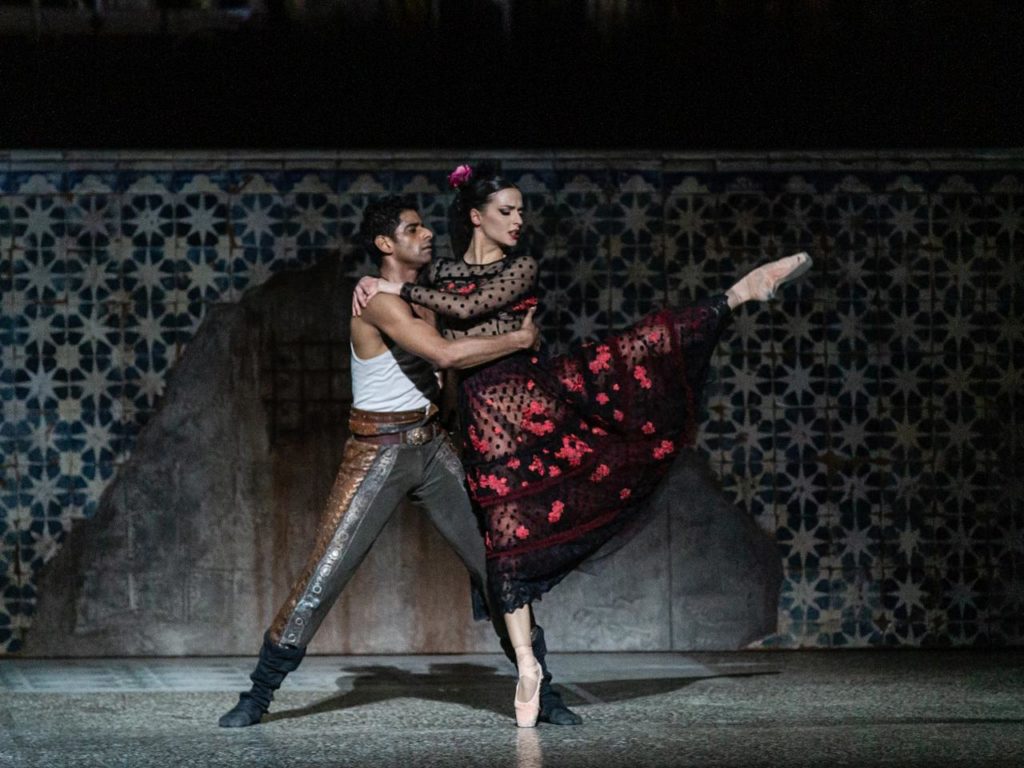 and, letting her go, ends up in prison himself. As he continues to fall for her, she can’t keep the hands off other men. There’s a lieutenant (Loïc Pireaux), whom Don José chokes out of jealousy; the English general, who gets shot by the smugglers during a fowling with Carmen and his pristine-whitely dressed entourage (a bird was shot too); and a bullfighter named Lucas (Alessio Rezza). Lucas is so conceited and camp that it’s mystery why Carmen nearly licks his bolero jacket and gives him a blow-job in the middle of the arena. Lucas dies without any interference from Don José; he is stomped to death by a horse. Don José, however, stabs Carmen’s husband Garcia (Gaetan Vermeulen) in revenge after Garcia executes the injured Remendado (Simone Agrò), another smuggler. The death toll rises: soldiers, smugglers, Carmen (stabbed by Don José as a poor solution to a hopeless situation), and Don José himself (who is hung in a strikingly simple and effective scene) are all dead by the end of the piece.
and, letting her go, ends up in prison himself. As he continues to fall for her, she can’t keep the hands off other men. There’s a lieutenant (Loïc Pireaux), whom Don José chokes out of jealousy; the English general, who gets shot by the smugglers during a fowling with Carmen and his pristine-whitely dressed entourage (a bird was shot too); and a bullfighter named Lucas (Alessio Rezza). Lucas is so conceited and camp that it’s mystery why Carmen nearly licks his bolero jacket and gives him a blow-job in the middle of the arena. Lucas dies without any interference from Don José; he is stomped to death by a horse. Don José, however, stabs Carmen’s husband Garcia (Gaetan Vermeulen) in revenge after Garcia executes the injured Remendado (Simone Agrò), another smuggler. The death toll rises: soldiers, smugglers, Carmen (stabbed by Don José as a poor solution to a hopeless situation), and Don José himself (who is hung in a strikingly simple and effective scene) are all dead by the end of the piece.
Bubeníček gives each protagonist and each group not only a distinctive dance vocabulary, but also gives plenty to dance. We watch sultry flamenco, perilous stick-fighting, and a virility-impregnated cape dance by the toreadors. Scenes buzzing with activity alternate with deeply passionate pas de deux. The first dance with Carmen and the soldiers reminded me of the pas de trois of Manon-Lescaut-Monsieur GM in “Manon”. In the second act, one or two group dances seemed repetitive, but apart from that, the variety of choreographic ideas was impressive and clichéd movement was avoided.
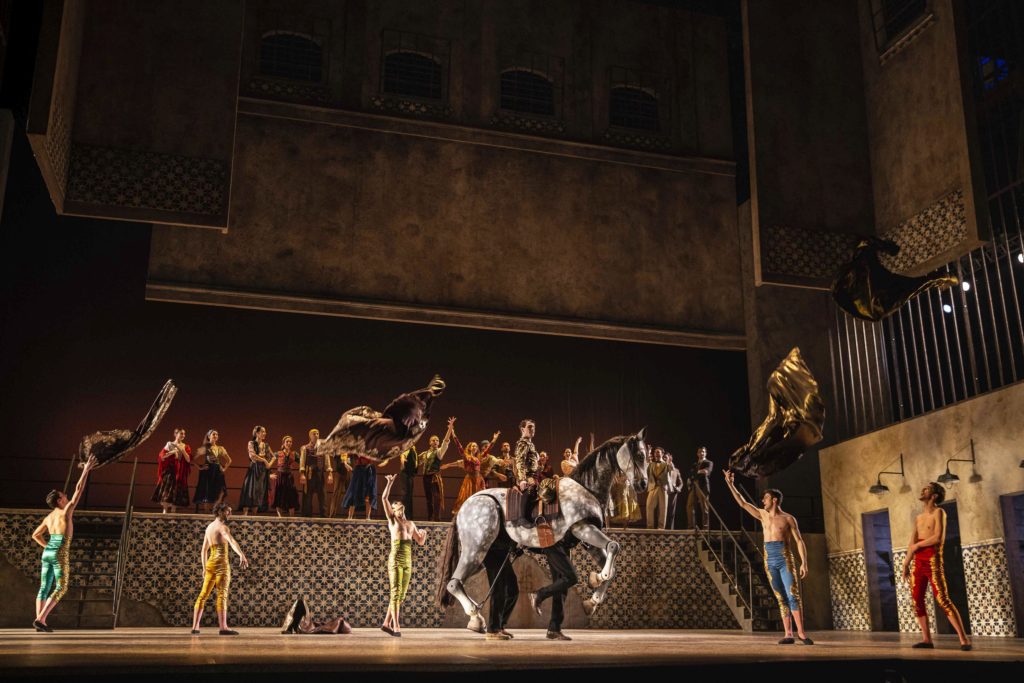 Susanna Salvi’s Carmen was proud and indomitable, playing with the men like a cat with mice. Chin up, chest out, and glancing about provocatively, they lay at her feet. Every time a relationship became serious, she ran away. The two-faced game that she played with the English general and Don José was disgusting. While Carmen coquettishly waved to the former, the latter hid just behind her. Carmen laughed at the men and humiliated Don José on multiple occasions. Her utter refusal to be chastened by him was poignant to witness. I wondered about her ethics, but despite everything I couldn’t condemn her as a thoroughly bad soul.
Susanna Salvi’s Carmen was proud and indomitable, playing with the men like a cat with mice. Chin up, chest out, and glancing about provocatively, they lay at her feet. Every time a relationship became serious, she ran away. The two-faced game that she played with the English general and Don José was disgusting. While Carmen coquettishly waved to the former, the latter hid just behind her. Carmen laughed at the men and humiliated Don José on multiple occasions. Her utter refusal to be chastened by him was poignant to witness. I wondered about her ethics, but despite everything I couldn’t condemn her as a thoroughly bad soul.
Amar Ramasar, a former principal dancer of New York City Ballet and, according to the New York Times, “one of [the company’s] brightest stars” and “leading lights”, has guested with the Ballet of the Teatro dell’Opera di Roma for the entire run of the production and has danced in all performances except for two matinees. His Don José was a strong man when Carmen was gracious with him and their romance was going smoothly. His sensuality was the manliest part of his character. Don José was impulsive and could be incalculably aggressive, but even then his main fury kept stuck in his chest like a lump. Often, his look revealed a great deal of vulnerability, grief and forlornness.
Both Salvi and Ramasar danced excellently, imbuing every moment with meaning and intensity, as did the rest of the cast. The secret hero of the show was, however, the dapper gray horse, which was so realistic standing in the misty background that I initially thought it was alive!Even its ears moved! This faithful horse mirrored every shift of the atmosphere. Its hooves trembled, it bolted, and once a stone in the hoof made it limp. It tried to comfort the distraught Don José, trampled Lucas to death, and carried Carmen and Don José at a gallop on their flight. Bravo to the workshop and to the two men who made this horse move! I couldn’t find their names on the cast list, but they did brilliantly.
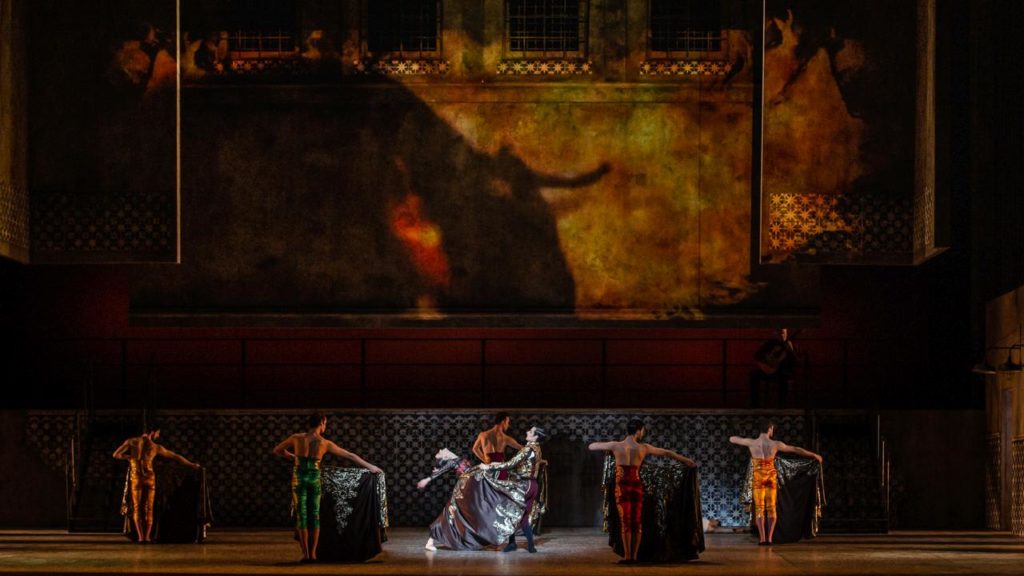
| Links: | Website of the Teatro dell’Opera di Roma | |
| Interview with Jiří Bubeníček (video) | ||
| report on “Carmen” (video) | ||
| Photos: | 1. | Susanna Salvi (Carmen) and Amar Ramasar (Don José), “Carmen” by Jiří Bubeníček, Ballet of the Teatro dell’Opera di Roma 2019 |
| 2. | Ensemble, “Carmen” by Jiří Bubeníček, Ballet of the Teatro dell’Opera di Roma 2019 | |
| 3. | Amar Ramasar (Don José), “Carmen” by Jiří Bubeníček, Ballet of the Teatro dell’Opera di Roma 2019 | |
| 4. | Ensemble, “Carmen” by Jiří Bubeníček, Ballet of the Teatro dell’Opera di Roma 2019 | |
| 5. | Amar Ramasar (Don José) and Susanna Salvi (Carmen), “Carmen” by Jiří Bubeníček, Ballet of the Teatro dell’Opera di Roma 2019 | |
| 6. | Alssio Rezza (Lucas) and ensemble, “Carmen” by Jiří Bubeníček, Ballet of the Teatro dell’Opera di Roma 2019 | |
| 7. | Susanna Salvi (Carmen), Alssio Rezza (Lucas) and ensemble, “Carmen” by Jiří Bubeníček, Ballet of the Teatro dell’Opera di Roma 2019 | |
| all photos © Yasuko Kageyama | ||
| Editing: | Jake Stepansky |
